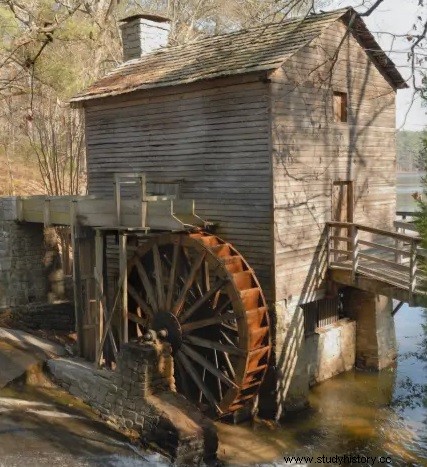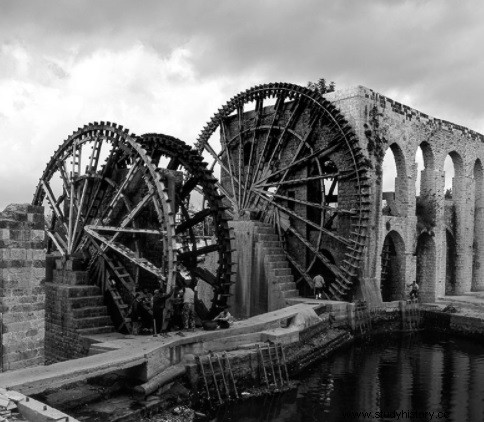 When was the first water mills still unknown? but it is very likely that the latter are the result of improvements made to the noria used in the Near East for irrigation. Archimedes' reflections on gears in the 3rd century BC announce the manufacture of the drive mechanisms that came to equip the first water mills, in particular those of Greece from the 1st century BC, well before the appearance of windmills. The device remains rudimentary:a vertical wooden paddle wheel whose shaft is directly connected to a grinding wheel rotates on another fixed grinding wheel. The watermill really took off in the 11th century.
When was the first water mills still unknown? but it is very likely that the latter are the result of improvements made to the noria used in the Near East for irrigation. Archimedes' reflections on gears in the 3rd century BC announce the manufacture of the drive mechanisms that came to equip the first water mills, in particular those of Greece from the 1st century BC, well before the appearance of windmills. The device remains rudimentary:a vertical wooden paddle wheel whose shaft is directly connected to a grinding wheel rotates on another fixed grinding wheel. The watermill really took off in the 11th century.
The invention of the first watermill
Major inventions for the history of humanity, the water mill and hydraulic energy were born thanks to ancestral know-how on canals and aqueducts. The vertical wheel watermill was imagined in the East in the 1st century BC. AD by anonymous inventors close to the field. It then spread in parallel in the Roman and Chinese empires, especially for the grinding of cereals, but also for the first artisanal uses. At the end of the Roman Empire, this innovation was present in all provinces, in the East as well as in the West.
 In the Middle Ages, this boom continued, and uses diversified:sawing wood, pestles and bellows for metallurgy, fulling for the cloth industry, papermaking, etc. More than 5,600 watermills are listed in England, after its conquest by William the Conqueror in 1066. In the 13th century, there were 28 in Rouen, 16 in Provins, and in the 14th century, 130 in Granada. In Toulouse, there are 60 mill-boats, including those of Bazacle. In Paris, no less than 50 mills are counted on the Seine, under bridges, in open water or even in the form of mill-boats.
In the Middle Ages, this boom continued, and uses diversified:sawing wood, pestles and bellows for metallurgy, fulling for the cloth industry, papermaking, etc. More than 5,600 watermills are listed in England, after its conquest by William the Conqueror in 1066. In the 13th century, there were 28 in Rouen, 16 in Provins, and in the 14th century, 130 in Granada. In Toulouse, there are 60 mill-boats, including those of Bazacle. In Paris, no less than 50 mills are counted on the Seine, under bridges, in open water or even in the form of mill-boats.
From this same period, we can also date the invention of the tide mill, on the western side of Europe. In the 18th century, the first pre-industrial concentrations appeared, for which hydraulics provided all the energy. In 1772, in France, more than 140 integrated forges were listed, with grinding workshops, blast furnace and forge:the great forge of Buffon, in Burgundy, still visible today, is a typical example with its eight hydraulic wheels arranged on three channels between the workshops.
From mill to hydraulic turbines
This is how hydraulic energy preceded the steam engine to allow, in the 19th century, the rise of the first large industrial spinning mills in England, then in France and in the USA. In this country, the textile industrial site of Lowell, in New England, created in 1822, employed 7,500 people in eight factories and had in 1847 191 water wheels. All the looms in the workshops were driven by mechanical transmissions from the hydraulic wheels, using gears, belts and rotating bars. From 1849, these water wheels were gradually replaced by turbines.
The invention of water turbines made it possible, from the middle of the 19th century, to use water energy much more efficiently than with water wheels. The Stéphanois Benoît Fourneyron, barely 25 years old but inspired by his teacher, Claude Burdin, made the first reaction turbine for industrial use in 1827, and tested it on a forge in the Jura. The chief engineer of the American Lowell site, James Francis, improved this wheel, and around 1855 developed the reaction turbine that would bear his name.
Around 1870, Lester Allan Pelton developed the Pelton wheel, an impulse turbine well suited for high heads, for the needs of the California mines. As soon as electricity was invented, turbines could be coupled to dynamos and alternators, and water power could be channeled farther from waterfalls. Today, this is the leading renewable energy generator, and it produces around 20% of the electricity consumed worldwide.
To go further
- Watermills in France, by Michèle Morin and Emile Couraud. Sutton, 2005.
